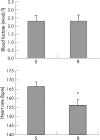Match activity and physiological responses during a junior female singles tennis tournament
- PMID: 17562743
- PMCID: PMC2465267
- DOI: 10.1136/bjsm.2007.036210
Match activity and physiological responses during a junior female singles tennis tournament
Abstract
Objective: To assess physiological load in conjunction with individual patterns of match-play activity in junior female tennis players during actual singles tennis competition.
Methods: Eight elite junior female tennis players (n = 8; mean (SD) age, 17.3 (1.9) years) took part in a 2 day invitational tournament. Activity pattern analysis was performed during competitive matches. Heart rate and blood lactate concentrations were measured during selected changeovers breaks in play.
Results: The activity profile of junior female players were: rally duration, (mean (SD)) 8.2 (5.2) s; rest time between rallies, 17.7 (6.5) s; effective playing time, 21.9 (3.8)%; strokes per rally, 2.7 (1.7); changes of direction per rally, 2.3 (1.4). The mean (SD) heart rate and blood lactate concentration recorded during the matches were 161 (5) beats/min and 2.0 (0.8) mmol/litre. Heart rate and blood lactate concentration values were influenced by the characteristics of the match and mean (SD) heart rate was significantly higher (p = 0.004) during service games (166 (15.4) beats/min) than in return games (156 (19.6) beats/min), while blood lactate concentrations were not significantly different (p = 0.83) between service (2.3 (0.6) mmol/litre) and return games (2.3 (0.9) mmol/litre). We found a significant (p<0.05) positive relationship between rally duration, strokes per rally, changes of direction and blood lactate and heart rate responses, with stronger correlations when the players were serving.
Conclusions: The physiological (ie, blood lactate and heart rate) responses associated with match play were influenced by the characteristics of the match (rally duration, strokes per rally and changes of direction), with higher heart rate on service position. Training programs should reflect these demands placed on female players during competitive match play.
Conflict of interest statement
Competing interests: None declared.
References
MeSH terms
Substances
LinkOut - more resources
Full Text Sources




